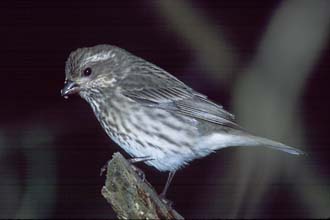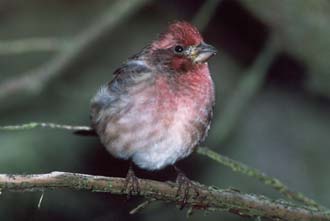

The finch was part of a small flock of Purple Finches at the Nunes Ranch (see below). While showing this slide in one of my classes I suddenly realized that this bird had many field marks of Cassin's Finch. Panic set in. Cassin's Finch is very rare in the San Francisco Bay Area and I have seen the species only once in over twenty five years of birding here. However, it is reported more often than that and I have wondered privately if some reports might be based on a misunderstanding of the characters which separate Purple from Cassin's and even House Finches.
This bird shows an array of confusing characters some of which are suggestive of Cassin's Finch to me. In particular, the streaky supercilium and mustachial area as well as the finely streaked undertail coverts are an excellent match for many Cassin's Finches and not typical of adult Purple Finches. However, juvenile Purple Finches often show finely streaked undertail coverts and I suspect that these may be retained juvenile feathers rather than individual variation or signs of hybridization. I am unaware of hybrids between Cassin's and Purple Finch but if they occur, they would be very difficult to detect.. I agree with those who identified this bird as a Purple Finch. The bill-shape, lack of eyering and generally dark, rather solid back pattern are all important clues.
Here are two additional Purple Finch images by Pete Peter LaTourrette from the same roll of film at the same time and place. I believe that these are different individuals from the mystery bird.
 |
 |
As pointed out by the expert commentary, the head and bill shape and overall coloration are more important than eye-color and on these characters, the bird is a Great-tailed. This species exhibits a considerable amount of geographic variation and is a relatively recent invader to California. Most California birds are thought to be derived from the smaller Q. m. nelsoni, but I the larger Q. m. monsoni also apparently occurs. I suspect these two forms probably intergrade here thus accounting for the high degree of variability of California birds. I think subspecific identification is unwise without measurements and examination in the hand.
The original mystery images are below:
What do you think these birds are? Please click here to view comments or add your own. Thank you very much for contributing your thoughts.